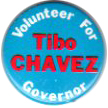In 1968, Citizens for Humphrey produced the first multicultural campaign button. Replete with images of voters from various ethnic and racial backgrounds, the political item reflected the candidate’s strategic effort to forge an alliance similar to the earlier campaigns of Franklin Roosevelt and John Kennedy.
Latinos were part of the Humphrey campaign from its beginning in spring 1968. Cristobal P. Aldrete of Austin, Texas, served as the top Latino staff person. A member of the GI Forum, he moved from the Democratic National Committee, where he served as the chairman’s special assistant for Mexican-American and Spanish Speaking Political Affairs, to the Humphrey campaign.
United Democrats for Humphrey, the primary campaign organization, listed two Spanish-surnamed individuals among the twenty-four names on its stationery: Alfonso J. Cervantes and Henry B. Gonzalez. Cervantes, mayor of St. Louis, was the grandson of a Spanish immigrant, and Gonzalez, a Mexican American, represented San Antonio, Texas, in Congress. He was elected in a special election in 1961 with the political assistance of the Kennedy-Johnson administration.
Humphrey, from Minnesota, a state with a small Mexican American, worked with the diverse Spanish-speaking community as vice president. In the 1968 general election campaign against Richard Nixon, Humphrey reached out to Puerto Ricans and Spanish Americans in New York, Cubans and Spanish Americans in Tampa, Mexican Americans and Puerto Ricans in Chicago, and Mexican Americans in numerous states, most notably Texas and California.



